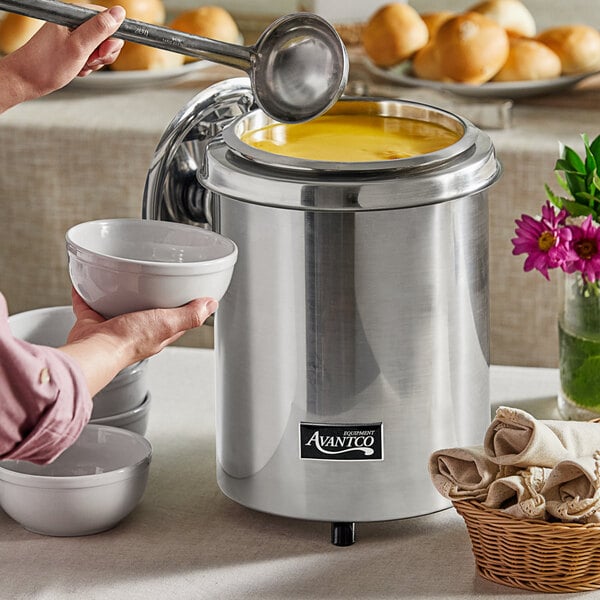
When you own a catering business, getting your portions right is essential to your success. Serve your guests too little food and they’ll be unsatisfied. Serve them too much and you risk increasing your food cost and creating food waste. We know how important it is to stay within a budget, which is why we made this catering portion guide to help you keep your portions in check while also keeping your customers happy.
Shop Catering SuppliesFood Quantities for Different Catered Events

Keep in mind that portion size and food quantities can be affected by a range of factors, like the type of meal you're serving and the length of the event. Here are some tips to help you adjust your portions:
- Type of Event: If the event is centered around a social gathering, like a wedding or baby shower, you can expect a lot of mingling and less eating. But if the meal is the main event, like a summer barbecue or Thanksgiving dinner, your guests usually come to eat. You should portion your dishes accordingly.
- Time of Day: For early events, like a continental breakfast and brunch, portions may be smaller because guests tend to eat less. Portions tend to be moderate for lunch events to meet the midday appetite. Larger portions are common for dinner events because guests typically expect a more substantial meal.
- Type of Service: During a plated meal, you can be conservative with the portion sizes of each dish. For a self-service or buffet-style event that utilizes vending kiosks and utility carts, you will typically need to provide larger portions per person.
- Cost of Food: Your food cost plays a role in portion sizes. Foods that are more cost-effective to make can be served in larger portions, while expensive foods (think caviar and wagyu beef) should be portioned with precision.
- Duration of Event: For shorter events, portion sizes may be smaller because there is less time to eat. During a longer event, guests may want to return for a second or third helping.
- Guest Preferences: Consider your guest demographics and preferences when planning servings per person. For instance, if your guests have dietary restrictions or are known to have hearty appetites, you may need to adjust your portion sizes accordingly.
Catering Portions
We've created some general guidelines to help you calculate the amount of food you need per person. These food quantity lists will give you a place to start, but each catered event is unique and will require further consideration.
Breakfast or Brunch Portions per Person

Here are some typical catering portion sizes for breakfast or brunch:
- Eggs and Omelets: 2 eggs per person or (1) 3-egg omelet per person
- Bacon or Sausage: 2 to 3 slices or links per person
- Pancakes or French Toast: 1 to 2 pieces per person
- Fruit: 1 cup of fruit per person
- Pastries: 1 to 2 pastries per person
- Coffee and Juice: 1 cup of coffee per person and 1 to 2 cups of juice per person
Appetizer Portions per Person
Use these food quantities per person as a guideline for your appetizer servings:
- Charcuterie: 2 to 3 ounces of charcuterie foods per person
- Passed Appetizers: 4 to 6 pieces per person per hour
- Stationary Appetizers: 2 to 3 ounces of food per person for each type of appetizer
- Buffet Style Appetizers: 6 to 8 pieces per person for a one-hour event
- Dips and Spreads: 2 to 3 tablespoons of dip per person
- Miniature Sandwiches and Sliders: 1 to 2 pieces per person if serving as a pre-meal appetizer, or 2 to 3 pieces per person if serving as a main entree
Lunch Portions per Person

Use these lunch portions as a guide for serving guests at mid-day events:
- Salad: 1 cup salad per person as a side and 3 cups salad per person as a main entree
- Soup: 8 to 10 ounces of soup per person
- Sandwiches: 1 whole sandwich per person
- Pasta: 6 to 8 ounces of pasta per person
- Pizza: 2 to 3 slices of pizza per person
- Sushi: 8 to 10 sushi bites per person
Dinner Portions per Person
If you're wondering how much salad or protein to serve your guests for a catered dinner, check out these typical portion sizes:
- Meat and Fish: 4 to 6 ounces of protein per person, 6 to 8 ounces of protein for buffets or barbecues
- Starches: 4 to 6 ounces of starches (like rice, pasta, or potatoes) per person
- Vegetables: 4 to 6 ounces of vegetables per person
- Salad: 1 cup salad per person as a side and 2 cups salad per person as a main entree
- Bread: 1 to 2 rolls or slices of bread per person
Dessert Portions per Person

If your guests saved room for dessert, you can use these guidelines to determine portion sizes:
- Cake: 1" x 2" slice per person for a single-layer cake and 1" x 1" to 1" x 2" slice per person for a layer cake
- Cupcakes: 1 standard cupcake per person and 2-3 mini cupcakes per person.
- Cookies: 1 to 2 cookies per person
- Pies and Tarts: 1 slice per person or 1 individual tart per person
- Dessert Bars: 1 to 2 brownies or blondies per person
Beverage Portions per Person
If you're serving alcohol at your catered event, there are some special considerations that come into play. Beverage portions are usually calculated by the hour and longer events will require more servings. Here are some typical beverage quantities to help get you started:
- Water: 8 to 10 ounces of water per guest per hour
- Wine: 2 1/2 glasses of wine per person (standard 5-ounce pour) per event (longer events may need more)
- Bottled or Canned Beer: 1 to 2 bottles of beer per person per hour
- Soft Drinks or Iced Tea: 1 drink per person for every hour
- Ice: 1 to 2 pounds of ice per person for drinks (food displays and packed coolers not included)
Catering Portion FAQs
We answer common questions about catering portions below:
How Much Food Should I Serve for a Buffet?
For a buffet setting, it is generally recommended to plan for around 1/2 to 1 pound of food per person. Keep in mind that the actual amount of food needed may vary depending on factors such as the type of event, the time of day, and the demographics of the attendees.
How Much Salad Should I Serve per Person?
For side salads, a typical serving size per person is around 1 cup. For main salads, you can plan on serving around 2 cups of salad per person.
How Much Meat Should I Serve per Person?
When it comes to serving meat at a catering event, a general rule of thumb is to plan for about 4-6 ounces of cooked meat per person for a plated meal. For self-serve events or buffets, increase this amount to 6 to 8 ounces.
What If I Run out of Food at My Catered Event?
Running out of food at a catered event can be a nightmare scenario for any caterer. Include backup items on your catering supplies checklist in case of emergencies. These could be simple dishes that can be quickly prepared or items that can be easily sourced from a nearby store. Determine which items are running out the fastest and prioritize replenishing those first. Consider adjusting the portion sizes of the remaining items. You can cut larger portions into smaller sizes to ensure that all guests get a taste. Remember that planning your portions beforehand will help prevent this from happening.
Proper portion control is key to managing costs effectively in the catering business. Oversized portions can result in excessive food waste and increased expenses, while undersized portions may lead to the need for additional servings, impacting labor costs and overall profitability. By accurately estimating portion sizes based on the number of guests and menu items, caterers can better control expenses and maximize their profits.





